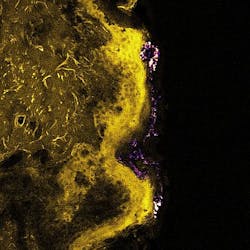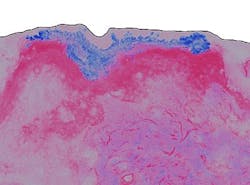Nonlinear optical microscopy assesses safety of ZnO nanoparticles in sunscreen
Zinc oxide (ZnO) nanoparticles are on the ingredients list of some commercially available sunscreen products, raising concerns about whether the particles may be absorbed beneath the outer layer of skin. To address this, an international team of scientists from Australia and Switzerland used a nonlinear optical microscopy technique to illuminate a skin sample with short pulses of laser light and measure a return signal, enabling them to test the concentration of ZnO nanoparticles at different skin depths. They found that the nanoparticles did not penetrate beneath the outermost layer of cells when applied to patches of excised skin.
The high optical absorption of ZnO nanoparticles in the UVA and UVB range, along with their transparency in the visible spectrum when mixed into lotions, makes them appealing candidates for inclusion in sunscreen cosmetics. However, the particles have been shown to be toxic to certain types of cells within the body, making it important to study the nanoparticlesâ fate after being applied to the skin. By characterizing the optical properties of ZnO nanoparticles, the Australian and Swiss research team found a way to quantitatively assess how far the nanoparticles might migrate into skin.
After having used the nonlinear optical microscopy technique, initial results showed that ZnO nanoparticles from a formulation that had been rubbed into skin patches for 5 minutes, incubated at body temperature for 8 hours, and then washed off, did not penetrate beneath the stratum corneum, or topmost layer of the skin. The new optical characterization should be a useful tool for future noninvasive in-vivo studies, the researchers write.
For more information on the work, which has been published in Biomedical Optics Express, please visit http://www.opticsinfobase.org/boe/abstract.cfm?uri=boe-2-12-3321.
-----
Follow us on Twitter, 'like' us on Facebook, and join our group on LinkedIn
Follow OptoIQ on your iPhone; download the free app here.
Subscribe now to BioOptics World magazine; it's free!


